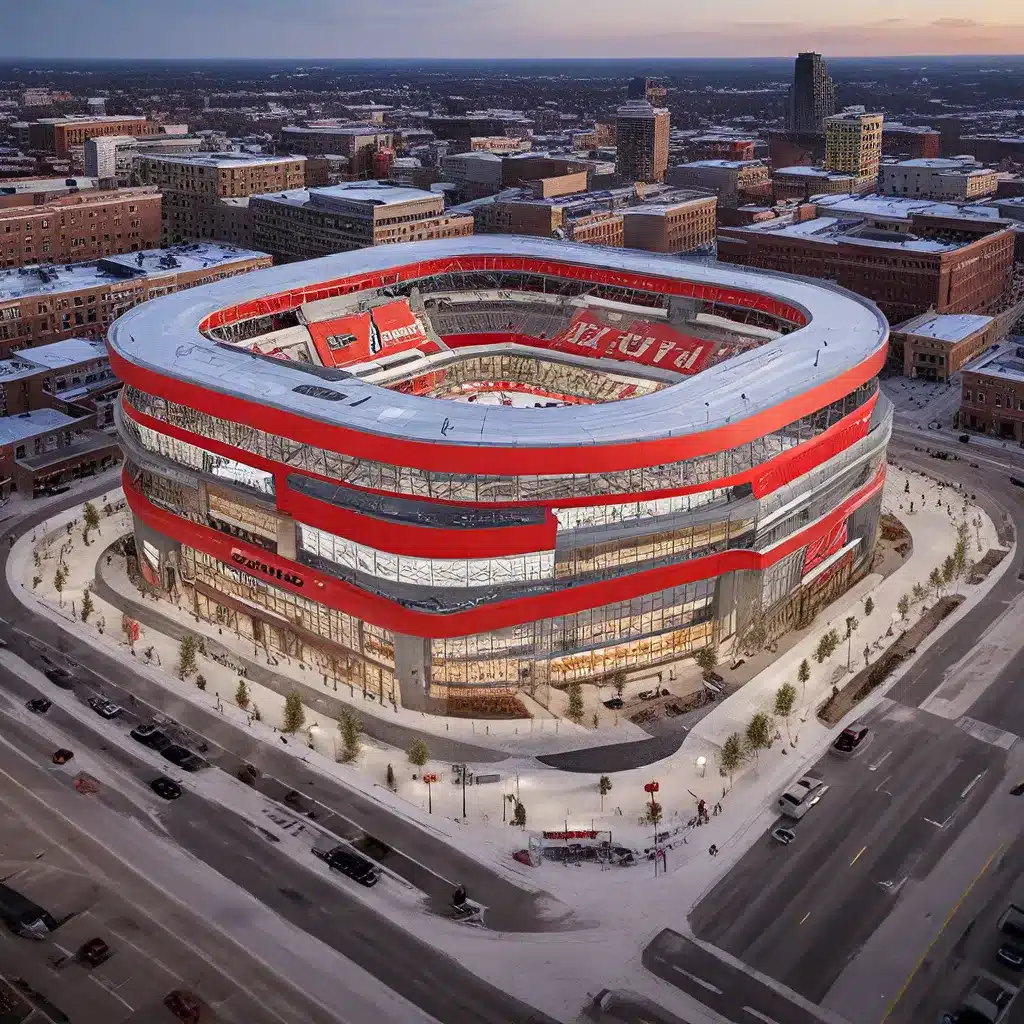
A Beacon of Innovation in Detroit’s Urban Renewal
Little Caesars Arena, located in the heart of downtown Detroit, Michigan, is a testament to the city’s remarkable transformation and commitment to sustainable urban development. As the new home of the Detroit Red Wings hockey team and the Detroit Pistons basketball team, this state-of-the-art facility has become a centerpiece of Detroit’s revitalization efforts, seamlessly blending cutting-edge architecture, environmental consciousness, and community engagement.
Architectural Masterpiece with a Green Twist
Designed by the renowned architectural firm of Rossetti Associates, Little Caesars Arena is a true architectural marvel that showcases the city’s dedication to sustainable design. The arena’s striking exterior features a sleek, modern aesthetic, with a bold red and black color scheme that pays homage to the Little Caesars brand. But beyond its visually appealing façade, the arena’s design is also deeply rooted in sustainability and environmental responsibility.
According to Masonry Magazine, the arena’s construction utilized a significant amount of locally sourced and produced materials, including masonry components that were manufactured in Michigan. This commitment to regional sourcing not only supports the local economy but also reduces the carbon footprint associated with long-distance transportation.
Furthermore, the arena’s design incorporates numerous energy-efficient features, such as high-performance insulation, LED lighting, and advanced HVAC systems. These sustainable elements work in harmony to minimize the building’s environmental impact and ensure that the arena operates in a more eco-friendly manner, contributing to Detroit’s broader goals of becoming a greener, more resilient city.
Embracing the Community’s Identity
Beyond its impressive architectural and environmental credentials, Little Caesars Arena has also become a hub for community engagement and civic pride. The arena’s design seamlessly integrates with the surrounding urban fabric, creating a cohesive and welcoming atmosphere that encourages public interaction and participation.
According to Building Enclosure Online, the arena’s public spaces and amenities, such as restaurants, retail outlets, and event spaces, are accessible to the local community, fostering a sense of ownership and belonging among residents. This approach not only strengthens the community’s connection to the arena but also contributes to the overall vibrancy and liveliness of the surrounding neighborhood.
Moreover, the arena’s programming reflects a deep understanding of the city’s cultural heritage and the needs of its diverse population. From hosting local sports teams to organizing community events and educational initiatives, Little Caesars Arena has become a hub for civic engagement, celebrating Detroit’s rich history and embracing its evolving identity.
A Catalyst for Sustainable Urban Renewal
The success of Little Caesars Arena as a model of sustainable design and community engagement has not gone unnoticed. The arena has become a symbol of Detroit’s resilience and a catalyst for the city’s ongoing urban renewal efforts. Its impact can be seen in the revitalization of the surrounding neighborhoods, with new businesses, residential developments, and public spaces emerging to complement the arena’s presence.
Old Stadium Journey highlights the arena’s role as a catalyst for this transformation, noting how its strategic location and innovative design have sparked a ripple effect of investment and development throughout the city. By creating a vibrant, connected, and sustainable urban environment, Little Caesars Arena has become a shining example of how sports facilities can serve as anchors for holistic community development.
Ongoing Innovations and Future Prospects
As the city of Detroit continues to evolve, Little Caesars Arena remains at the forefront of sustainable urban design and community engagement. The arena’s management team is constantly exploring new ways to enhance its environmental performance and strengthen its ties with the local community.
One area of ongoing innovation is the integration of advanced Internet of Things (IoT) technologies and artificial intelligence (AI). By leveraging these cutting-edge systems, the arena can optimize energy efficiency, improve crowd management, and collect valuable data to inform future decision-making. This commitment to technological innovation aligns with Detroit’s broader smart city initiatives, further solidifying the arena’s role as a hub for urban renewal and sustainable development.
Moreover, the arena’s design and programming continue to adapt to the changing needs and preferences of its users. As the city’s population and demographics evolve, the arena’s management team remains dedicated to preserving the arena’s architectural integrity while ensuring that it remains a highly relevant and accessible community asset.
Conclusion: A Shining Example of Sustainable Urban Design
Little Caesars Arena stands as a shining example of how sports facilities can be designed and operated in a sustainable and community-centric manner. By seamlessly blending innovative architecture, environmental consciousness, and a deep understanding of the local community, this arena has become a beacon of urban renewal, inspiring other cities to follow suit in creating vibrant, resilient, and sustainable urban environments.
As Detroit continues its remarkable transformation, Little Caesars Arena will undoubtedly remain a centerpiece of the city’s revitalization efforts, serving as a model for urban planners, architects, and community leaders around the world. Through its commitment to sustainability, community engagement, and technological innovation, this arena has set a new standard for the role of sports facilities in the 21st-century city.

